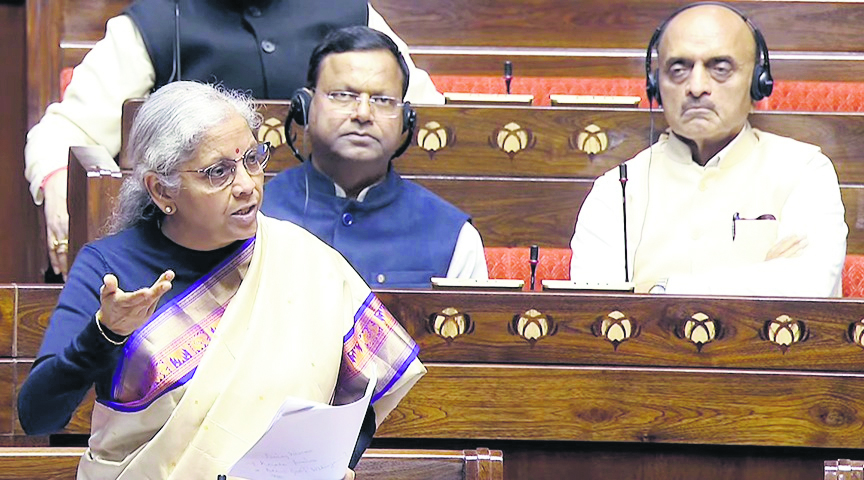
Lost decade, crisis of leadership, scams, policy misadventures, says White Paper on economy.
An inheritance of a reform ready healthy economy rendered non-performing in 10 years, squandering away of credit for the 1991 economic changes after coming to power in 2004 and the UPA Government’s quest to maintain high economic growth by any means after the global financial crisis of 2008, severely undermining the macroeconomic foundations are among the key miscalculations of governance by the Congress led coalition in power between 2004-2014, according to the White Paper presented by Finance Minister Nirmala Sitharaman on Thursday.
The Paper highlights banking crisis as one of the most important and infamous legacies of the UPA government. The banking crisis in 2014 was massive, and the absolute sum at stake was too large. The gross advances by public sector banks were only ₹6.6 lakh crore in March 2004 while in March 2012, it was ₹39.0 lakh crore, the Paper states.
It also blamed the UPA’s inability to recognise all the problem loans, leaving ‘much under the hood’. The Paper quotes a Credit Suisse report published in March 2014 that the top 200 companies with an interest coverage ratio of less than one, in fact, owed about ₹8.6 lakh crore to banks. Nearly 44 per cent of those loans (₹3.8 lakh crore) were yet to be recognised as problem assets. That alone would have added another 6.7 per cent to the GNPA ratio.
The Paper rues the large-scale mismanagement of India’s external engagements, especially external vulnerability — in an era where capital flows dominate — because of over-dependence on external commercial borrowings (ECB). This was also visible in 2013 when the US dollar rose sharply and the UPA Government compromised external and macroeconomic stability, sending the currency plunging in 2013. From its high to low, against the US dollar between 2011 and 2013, the Indian rupee plunged 36 per cent. The Paper dismisses the famous Foreign Currency Non-Resident (FCNR(B)) deposit window for NRIs as “actually a call for help when there was a large depletion of the foreign exchange reserves”. Detailing the flaws in the UPA Government’s approach, the White Paper points out that foreign exchange reserves had declined from around $294 billion in July 2011 to around $256 billion in August 2013. By end-September 2013, forex reserves were just enough to finance little over 6 months of imports, down from 17 months in end-March 2004, the paper reveals.
The UPA Government’s response to the 2008 global financial crisis through a fiscal stimulus package to combat the spill-over effects, was worse than the problem it sought to address, since, according to the White Paper, ‘it was way beyond the capacity of the Union Government to finance and sustain.’ Interestingly, the stimulus did not seem to bear any correlation with the outcomes it sought to achieve because Indian economy was not unduly affected by the crisis. During the crisis, India’s growth slowed to 3.1 per cent in FY09 but recovered swiftly to 7.9 per cent in FY10.
Under the UPA government, public finances were brought to a terrible state, with a high fiscal deficit, the Paper alleges. One instance of this was the special securities (oil bonds) in lieu of cash subsidy issued to the oil marketing companies, fertiliser companies and Food Corporation of India by the UPA government totalling a little over ₹1.9 lakh crore in the five years from FY06 to FY10. The Paper accuses the UPA of hiding them to keep the fiscal deficit down whereas their inclusion in the subsidy bill for each year would have swelled the fiscal deficits and revenue deficits. The Paper contends that this fiscal mismanagement led to the fiscal deficit being far higher than it had expected, and to the Government borrowing 27 per cent more from the market than what it had budgeted for in 2011-12. Not only did the UPA Government borrow heavily from the market, but the funds raised were applied unproductively.
The Paper also brings out a serious neglect of infrastructure creation, with only about 16,000 kilometres — of the 40,000 km planned development — added by the UPA Government, while 24,000 km of national highways were added during the NDA regime from 1997 to 2002. There was poor policy planning and execution resulting in large unspent funds for many social sector schemes during the UPA years, largest power outage in July 2012 with more than 24,000 MW of generation capacity lying idle due to lack of fuels like coal and gas and leaving 62 crore people in darkness and lack of transparency in the process of allocation of spectrum in telecom sector leading up to 2G scam.
The Paper eulogises the proactive efforts and policy measures of the BJP led NDA Government, since taking over in 2014, to revamp and overhaul systems and processes, spearhead the digital revolution, vaccinate the entire eligible population using indigenous vaccines, substantially diversifying exports and lay the foundation for a comprehensive reform process. From reporting India’s improved near-term growth outlook and favourable balance of risks in 2015 by the IMF and from Morgan Stanley’s positioning of India in the league of ‘Fragile Five ‘– a group comprising emerging economies with weak macroeconomic fundamentals – to India’s leap into the league of ‘Top Five’ in just about a decade.